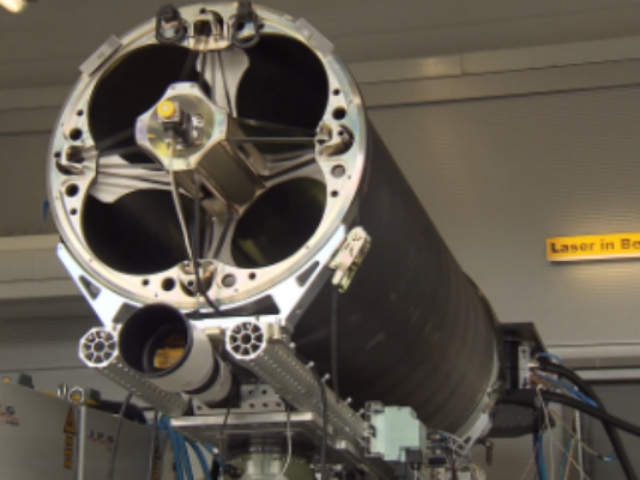 The growing use of micro-UAVs for intrusive surveillance has spurred MBDA Germany to develop a laser technology demonstrator it claims can knock out a small drone at a range of 3 kilometers.
The growing use of micro-UAVs for intrusive surveillance has spurred MBDA Germany to develop a laser technology demonstrator it claims can knock out a small drone at a range of 3 kilometers.
The laser, which combines the power of four 10 kilowatt lasers focused into one beam to produce a 40 kilowatt beam, will be able to destroy mini-UAVs at a range of 5 kilometers once it reaches operational status, potentially within five years, said company official Markus Martinstetter at a Paris Air Show briefing on Wednesday.
Test firings at the firm’s range in Schrobenhausen, Germany have already seen a 20 kilowatt beam cause a micro drone flying 500 meters away to burst into flames and crash.
A video shown in Paris shows the laser destroying a UAV in 3.39 seconds. Testing in recent weeks has focused on autonomous target acquisition.
MBDA Germany, the German arm of the European missiles house, is banking on lasers as the best way to counteract micro-UAVs, in the belief that a laser beam can be modulated to warn UAV users to withdraw their drones or to destroy the UAV.
Explaining demand for the product, Martinstetter pointed to a recent incident when a micro-UAV flew close to German chancellor Angela Merkel during a public appearance. “he air defense system in that case was her bodyguard, who picked up the UAV,” he said.
“You can buy these things on the internet and easily put explosives on them but there is no efficient protection against them,” he added.
The firm has been experimenting for more than a decade on the technology, deciding early on to use an off-the-shelf, fiber laser, while adding its own target acquisition technology. The system, which the German Ministry of Defense is part funding, envisages an external sensor like a radar spotting the target before a low power laser beam illuminates it for better targeting. An optical sensor then locks onto the target and guides the laser.
The four, 10 kilowatt lasers are focused into one beam by a mirror. The sytems’ efficiency is about 30 percent, meaning that 400 to 500 kilowatts of battery power are required to produce the 100 kilowatt laser.
“We have designed a system with six lasers and 8 to 10 is possible, but 4-6 is the best number for reasons of size,” said Martinstetter. The four laser, 100 kilowatt set-up would be mounted on the same type truck used to ferry the MEADS missile defense system, he said.
At a briefing on Wednesday, MBDA also outlined other potential uses of the laser. In the short term, the firm plans to have the ability to knock out IEDs using a 5 to 20 kilowatt laser mounted on a vehicle at a range of less than 500 meters , as well as the ability to blind or destroy optics using a 5 kilowatt laser at a range of 2.5 kilometers.
Five years after the signing of a full development contract, the firm would be able to offer a counter piracy laser with a range of less than 1,000 meters using a 10-40 kilowatt laser. A mid to long range plan is for an antimissile laser firing a 100 kilowatt beam up to 3 milometers .
“We are now working on a deployable, ruggedized laser demonstrator, but the principal technology is proven,” said Martinstetter. The firm now awaited further funding from the German MoD, he said.
Israeli firm Aeronautics is promoting a so-called “Suicide Drone” at Paris. The Orbiter IK is a loitering, expendable mini-drone which carries 2.2 kg of explosives in its nose, as well as a camera, and can be detonated if a target is found.
Asked about the Orbiter, Martinstetter said, “That is the class (of product) that could be our target.” Destroying a drone packed with explosives would be easier, he added.
German firm Rheinmettall is working on a similar laser system to MBDA’s, and Martinstetter did not rule out the two firms collaborating.
Source: Defense News
